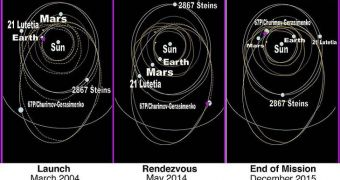The European Space Agency's (ESA) Rosetta spacecraft is currently en-route towards the inner asteroid belt, the circle of space debris that exists between the orbits of Mars and Jupiter. The feature contains numerous interesting structures, including the dwarf planet Ceres and the large asteroids Vesta, which are the targets of the NASA Dawn mission. But Rosetta also has a very interesting target, the rock called 21 Lutetia. Many astronomers have made assumptions as to where the asteroid may have come from, and what its traits are, but no direct observations of it have ever been conducted.
Now, experts set out to infer some of the possible scenarios that Rosetta may come across, Technology Review reports. The ESA spacecraft is, at this point, scheduled to fly past the interesting object in July. The probe was launched in 2004, aboard an Ariane 5G+ heavy-lift delivery system, and is scheduled to conclude its mission in 2015, when it will reenter the inner solar system. Until then, it will conduct scientific observations of interesting targets such as 21 Lutetia.
Astronomers classify the object as an M-type asteroid, which means it should be mainly made up of iron and nickel. However, spectral analysis of the structure reveals no signs of metals in its composition. This discovery has had experts speculating as to its origins for many years. One of the main reasons why the Rosetta space probe was made to investigate it is because scientists are very curious as to what the actual object is made of. Astronomers at the Observatoire de Paris, led by expert Irina Belskaya, are now engaged in a little fun game of “Guess,” where they try to infer what Rosetta will most likely find.
The group believes that 21 Lutetia will be the shape of a potato, with the rough dimensions of 132 by 101 by 76 kilometers. The experts believe that its surface will be the most interesting aspect, saying that the mineral composition and the texture of this space rock will provide the most tantalizing clues as to its origins. The group also believes that the overall composition of the asteroid will most likely resemble that of carbonaceous chondrite meteorites found on Earth. They don't believe that the rock will have too many connections, at least as far as its composition goes, to classic iron-nickel asteroids.

 14 DAY TRIAL //
14 DAY TRIAL //